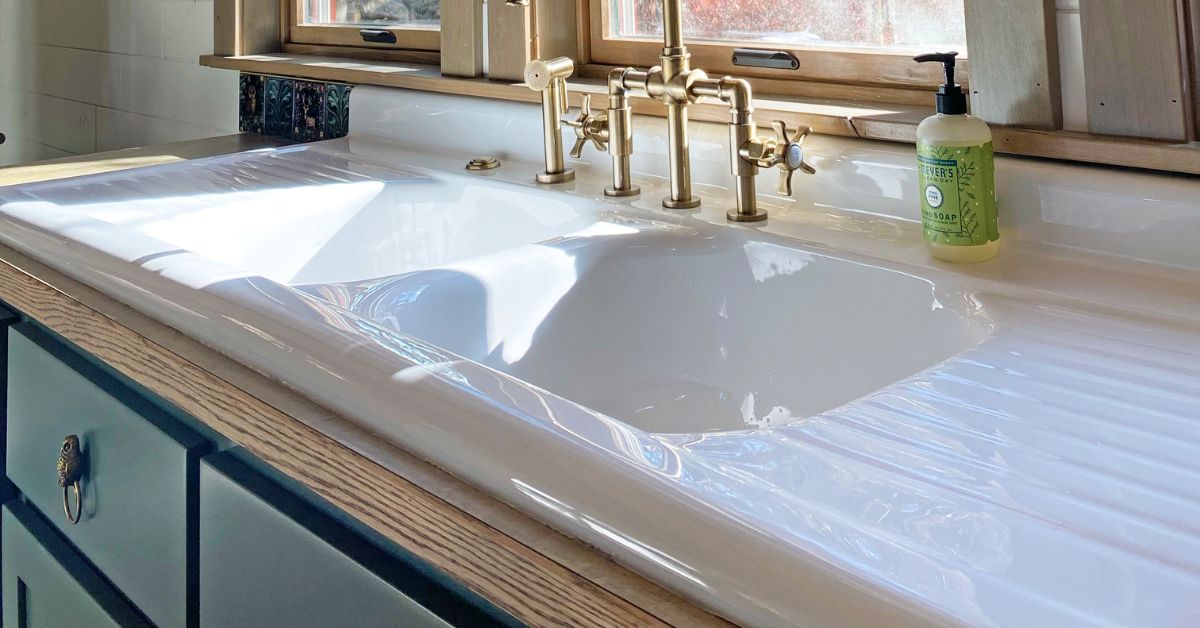
Fiberglass sinks, with their glossy finish and durable structure, bring functionality and charm to your home. However, maintaining their pristine appearance requires intentional care. Over time, stains, grime, and wear can dull the sink’s surface, but with the right techniques, you can keep your sinks looking as fresh and clean as the day you bought them.
This guide to cleaning and maintaining your fiberglass sink will teach you everything you need to know to extend the lifespan of your sink and preserve its shine for years to come!
Rinse After Every Use
When using your sink, make a habit of rinsing it thoroughly with warm water after. Rinsing clears away food particles, soap residue, and dirt before they can cling to the surface. Leaving debris in the sink for too long can result in unsightly stains or abrasions. A quick rinse takes only a moment but will go a long way toward preserving the gloss of your fiberglass sink.
Use a Mild Cleaner Regularly
Select a nonabrasive, mild cleaner to wash your fiberglass sink every week. Products designed specifically for delicate surfaces work best, as harsher chemicals can dull the finish or cause discoloration.
Apply the cleaner with a soft sponge, gently scrubbing in circular motions to remove grime without scratching. Once you’ve cleaned the surface thoroughly, rinse the area with clear water to wash away residue. This process helps preserve the integrity of the material while keeping it spotless.
Avoid Stiff Brushes and Scouring Pads
Never attempt to clean your fiberglass sink with abrasive tools, such as steel wool, scouring pads, or stiff-bristled brushes. These items can scratch the sink’s glossy surface, leaving behind permanent damage that’s hard to repair. Instead, for effective and gentle cleaning, rely on soft sponges, microfiber cloths, and non-scratch pads. When persistent stains or grime require extra effort, opt for appropriate cleaning products rather than rough tools to protect your sink from harm.
Remove Mineral Deposits Promptly
When hard water dries on your sink, it can leave behind mineral deposits that are tough to remove. To handle this issue, gently clean the area with a solution of half-white vinegar and half-water. Dampen a soft cloth with the mixture and wipe away the buildup, repeating as needed. Rinse the sink after cleaning to prevent vinegar odor or residual acidity. Tackling these deposits quickly helps maintain your sink’s shine and prevents further staining.
Treat Stains With Baking Soda
Baking soda works as a gentle yet effective remedy for stubborn stains. Sprinkle a small amount onto the affected area, then moisten the powder slightly until it forms a paste. Use a soft sponge to rub the paste in small circles, carefully lifting the stain without scratching the surface. Rinse away all traces of baking soda when finished. This method is ideal for handling coffee, tea, and food stains, leaving your sink refreshed and spotless.

Always Dry the Sink After Cleaning
As you complete each cleaning task, dry the sink with a clean, soft towel. Water left to air-dry can cause spots or streaks to form, undermining your cleaning efforts. Wiping the sink dry keeps it gleaming and prevents mineral buildup. This step also helps you spot-check areas where grime or stains may need further attention.
Polish the Surface for Extra Shine
After you’re done cleaning, polish the sink and restore its original bright finish. Use a fiberglass-safe polish or car wax once a month, applying it in small amounts with a microfiber cloth. Buff the surface in circular motions, and continue until it feels smooth and radiant. This protective layer guards the sink against scratches and stains, making everyday use far easier on its delicate finish.
Avoid Harsh Chemicals
When caring for a fiberglass sink, resist the temptation to use bleach, ammonia, or other strong chemical agents. These substances can eat away at the surface or leave permanent discoloration. Instead of risking damage, rely on gentler alternatives that safeguard the sink’s glossy exterior.
Be Mindful of Heat
Excessive heat can weaken fiberglass over time, leading to cracks or warping. Avoid placing hot pans, pots, or utensils directly into the sink when possible. Use a trivet or a heat-resistant mat to set hot cookware aside, and never pour boiling water directly into the sink. By being cautious with extreme heat, you’ll protect the sink material’s durability and overall shape.

Prevent Scratches With Dish Racks
Protect your fiberglass sink from unnecessary scratches by using a dish rack or mat that covers the bottom. These tools create a barrier between sharp utensils, heavy cookware, and the sink’s surface. A basic investment such as this keeps normal wear and tear from leaving lasting marks, extending the sink’s lifespan.
Clean the Drain Area Thoroughly
While focusing on the sink itself, don’t overlook the area around the drain. Soap and grime often accumulate there, creating unpleasant odors and potential clogs. Use a mild cleaner to gently scrub the edges and inside of the drain. A clean drain prevents unwanted buildup so the sink remains fresh and functional.
Watch for Leaks or Cracks
Inspect your sink regularly for signs of damage, such as leaks or small cracks. Addressing these issues early can prevent them from escalating into costly problems. If you discover a minor issue, consult with a professional to assess repair options. Taking care of structural concerns helps maintain a functional sink over time.
Avoid Leaving Heavy Stains Untreated
When you notice a spill or stain in your fiberglass sink, clean it promptly to prevent it from becoming a permanent blemish. Discoloration can happen over time when you allow certain substances to sit on the sink over time. Quick action makes sure that your sink retains its appealing finish without prolonged scrubbing sessions.
Schedule Deep Cleaning on Occasion
Even with a consistent routine, deep cleaning now and then keeps your fiberglass sink truly spotless. Devote time every few months to carefully scrub all corners, polish the surface, and check for buildup you might have missed during daily cleaning. This effort refreshes the sink and reinforces its shine, leaving it as good as new.
Small habits like rinsing regularly, using gentle cleaners, and drying thoroughly are just some of the ways you must clean and maintain your fiberglass sink. A clean, well-loved sink enhances the functionality and appearance of your kitchen, becoming a centerpiece you can take pride in, but you also need the right sink in the first place. That’s where NBI Drainboard Sinks can help. With one of our vintage farmhouse bathroom sinks, you can make sure your space and sinks are vibrant and welcoming!
